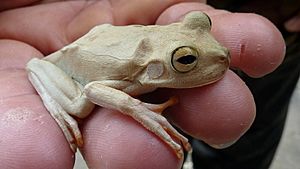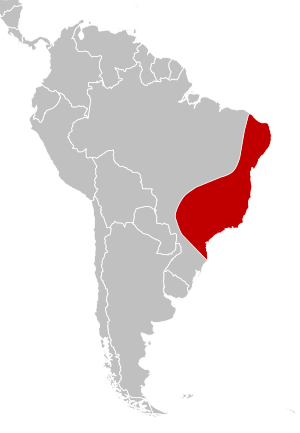Emerald-eyed tree frog facts for kids
Quick facts for kids Emerald-eyed tree frog |
|
|---|---|
 |
|
| Conservation status | |
| Scientific classification | |
 |
|
| Synonyms | |
|
Hypsiboas crepitans (Wied-Neuwied, 1824) |
The emerald-eyed tree frog (Boana crepitans) is a type of frog that belongs to the Hylidae family. You can mostly find this frog in the Atlantic Forest area of Brazil. Some frogs that people used to think were Boana crepitans are now known to be different species. These are called Boana xerophylla and Boana platanera.
Contents
What Does the Emerald-Eyed Tree Frog Look Like?
Adult Frogs
Adult emerald-eyed tree frogs are quite large. They have long, thin arms and legs. Male frogs can grow up to 59 millimeters long. Female frogs are a bit bigger, reaching up to 68 millimeters. Males also have a special, sharp spine near their thumb.
Colors and Markings
The back of the frog is usually a pinkish-tan color. It might have some darker brown spots or blotches. Often, there is a thin, dark line down the middle of its back. You can also see dark stripes on the top and back of its thighs.
Hidden Areas
The parts of the frog that are usually hidden, like the underside of its legs, are similar in color to its back. However, the dark stripes on the back of its thighs are still noticeable.
Its Eyes
The frog's eyes are grey. They often have a shiny bronze or yellowish tint, which makes them look special.
Hands and Feet
The emerald-eyed tree frog does not have a lot of webbing between its fingers and toes. The webbing it does have is light in color.
Where Does the Emerald-Eyed Tree Frog Live?
This frog can live in many different places. It likes humid tropical forests and even drier, semi-desert areas. You can also find it in grasslands and open plains. It lives in pastures and lower mountain forests too.
The emerald-eyed tree frog is active at night. It lives in trees and shrubs, especially near water. These frogs often sit on leaves or other plants close to streams. They lay their eggs in temporary pools of water when the rainy season starts. Sometimes, you might even spot these frogs on the ground. They can survive in places where humans have changed the environment a lot, like in cities and around houses.
Life Cycle of the Emerald-Eyed Tree Frog
Breeding Season
Emerald-eyed tree frogs breed for most of the rainy season. Male frogs call from the edges of temporary ponds. They also call from grassy areas that are flooded with water. This is how they attract females.
Eggs
A female frog can lay a lot of eggs at once. She might lay over 1,000 eggs in a single breeding event!
Tadpoles
The tadpoles of this frog are grey or light brown. Their tails often have a yellowish color. The body of a tadpole is oval-shaped. It has a long tail that ends in a distinct point. The top part of the tadpole's tail fin is much deeper than the bottom part.
See also
 In Spanish: Rana Blanca para niños
In Spanish: Rana Blanca para niños


